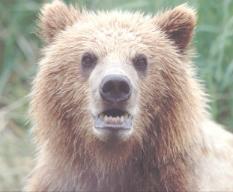
Six of the world's eight species of bear are threatened with extinction, according to a report from the World Conservation Union (IUCN).
The smallest species of bear, the sun bear, has been included on the list for the first time, while the giant panda remains endangered, despite comprehensive conservation efforts in China.
The IUCN, which has updated the status of the seven species of terrestrial bear on its Red List of Threatened Species, said despite claims that panda populations were on the rise due to a ban on logging, the creation of panda reserves and reforestation programmes, it still considered the bear to be endangered.
"Quite a bit is now known about the ecology of giant pandas, and substantial work and expense has been aimed at trying to estimate total numbers of these animals. However, these estimates are imprecise and prone to significant error," said David Garshelis, the co-chairman of the IUCN bear specialist group.
"Too much uncertainty exists to justify changing their status to vulnerable. It would be unwise to assume that in less than 10 years under the new habitat improvement policies in China that panda populations could have dramatically increased," he added.
The sun bear, which lives in south-east Asia, Sumatra and Borneo, has been included on the list for the first time, and is classed as vulnerable. It was previously listed as "data deficient" because not enough was known about the species.
The IUCN bear specialist group, which announced its findings after a meeting in Mexico over the weekend, estimates that sun bears have declined by at least 30% over the past 30 years and would "continue to decline at this rate".
"Although we still have a lot to learn about the biology and ecology of this species, we are quite certain that it is in trouble," said Rob Steinmetz, the co-chairman of the IUCN bear specialist group's sun bear expert team.
"Deforestation has reduced both the area and quality of their habitat. Where habitat is now protected, commercial poaching remains a significant threat."
Steinmetz said the IUCN was working with government, protected area managers, conservation groups and local people "to prevent extinctions of the many small, isolated sun bear populations that remain in many parts of south-east Asia."
Bears in Asia and South America are the most in need of urgent conservation action, the IUCN said, with Asiatic black bears, Andean bears (formerly called spectacled bears), and sloth bears all listed as vulnerable.
Sloth bears live on the Indian subcontinent in Sri Lanka, India, Bhutan, Nepal and Bangladesh, where habitat loss has been severe. They have found sanctuary mainly in the reserves set up to protect tigers. The bear specialist group has indicated this species may have disappeared entirely from Bangladesh.
Threatened existence
The main threat to bears across south-east Asia comes from poaching. Although illegal, poachers are prepared the risk the small chance of being caught against the lucrative gains they can make from sales on the black market.
Prized bear body parts include the gall bladder, which is used in traditional Chinese medicine, and their paw, which is considered to be a delicacy.
Another threat to bear populations comes from living in close proximity to human settlements. Bears are often killed when they prey on livestock or raid crops, or killed when the roam too close to a village because they are seen as a threat to human safety.
"Although the bear population estimates for Asia are not as reliable as we would like, we estimate that bears in south-east Asia are declining at a particularly rapid rate due to extensive loss of forest habitat combined with rampant poaching," said Garshelis.
The polar bear, which has recently become a symbol for climate change and its effect on animals, is listed as vulnerable, but as it is technically a marine mammal it is distinct from the other seven terrestrial bears and has a different specialist group.
Only two bears - the brown bear and the American black bear - were listed as being of "least concern".
Brown bears, the most widespread species, are not listed as being threatened globally because large numbers still live in Russia, Canada, Alaska and some parts of Europe. However, the IUCN said very small, isolated and "highly vulnerable" populations exist in southern Europe and central and southern Asia.
Several brown bear populations are protected under national or provincial laws, while grizzly bears are considered threatened under the US Endangered Species Act everywhere except Alaska.
Only the American black bear is secure throughout its population range, which includes Canada, the US and Mexico. With a population of 900,000, the IUCN said there were more than twice as many black bears than all other species combined. They are legally hunted in most parts of their range.
Bruce McLellan, another co-chairman of the bear specialist group, said: "An enormous amount of effort and funding for conservation and management continues to be directed at bears in North America where their status is relatively favorable.
"It is unfortunate that so little is directed at bears in Asia and South America where the need is extreme. We are trying to change this situation, but success is slow."
Guardian Unlimited © Guardian News and Media Limited 2007
photo credit Hermann J Knippertz, AP file
